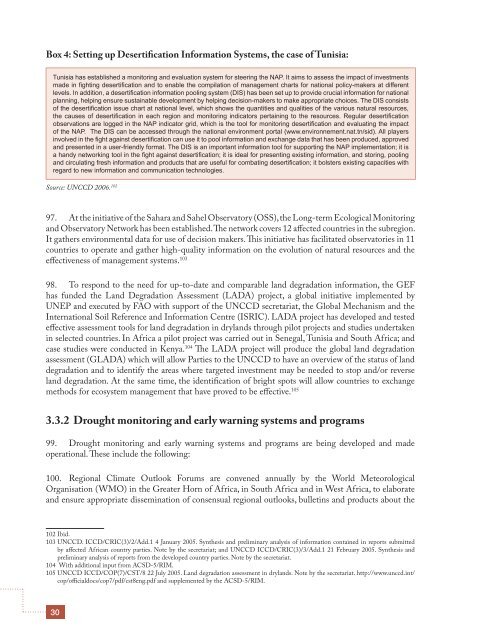drought desertification - United Nations Economic Commission for ...
drought desertification - United Nations Economic Commission for ...
drought desertification - United Nations Economic Commission for ...
Create successful ePaper yourself
Turn your PDF publications into a flip-book with our unique Google optimized e-Paper software.
Box 4: Setting up Desertification In<strong>for</strong>mation Systems, the case of Tunisia:<br />
Tunisia has established a monitoring and evaluation system <strong>for</strong> steering the NAP. It aims to assess the impact of investments<br />
made in fighting <strong>desertification</strong> and to enable the compilation of management charts <strong>for</strong> national policy-makers at different<br />
levels. In addition, a <strong>desertification</strong> in<strong>for</strong>mation pooling system (DIS) has been set up to provide crucial in<strong>for</strong>mation <strong>for</strong> national<br />
planning, helping ensure sustainable development by helping decision-makers to make appropriate choices. The DIS consists<br />
of the <strong>desertification</strong> issue chart at national level, which shows the quantities and qualities of the various natural resources,<br />
the causes of <strong>desertification</strong> in each region and monitoring indicators pertaining to the resources. Regular <strong>desertification</strong><br />
observations are logged in the NAP indicator grid, which is the tool <strong>for</strong> monitoring <strong>desertification</strong> and evaluating the impact<br />
of the NAP. The DIS can be accessed through the national environment portal (www.environnement.nat.tn/sid). All players<br />
involved in the fight against <strong>desertification</strong> can use it to pool in<strong>for</strong>mation and exchange data that has been produced, approved<br />
and presented in a user-friendly <strong>for</strong>mat. The DIS is an important in<strong>for</strong>mation tool <strong>for</strong> supporting the NAP implementation; it is<br />
a handy networking tool in the fight against <strong>desertification</strong>; it is ideal <strong>for</strong> presenting existing in<strong>for</strong>mation, and storing, pooling<br />
and circulating fresh in<strong>for</strong>mation and products that are useful <strong>for</strong> combating <strong>desertification</strong>; it bolsters existing capacities with<br />
regard to new in<strong>for</strong>mation and communication technologies.<br />
Source: UNCCD 2006. 102<br />
97. At the initiative of the Sahara and Sahel Observatory (OSS), the Long-term Ecological Monitoring<br />
and Observatory Network has been established. The network covers 12 affected countries in the subregion.<br />
It gathers environmental data <strong>for</strong> use of decision makers. This initiative has facilitated observatories in 11<br />
countries to operate and gather high-quality in<strong>for</strong>mation on the evolution of natural resources and the<br />
effectiveness of management systems. 103<br />
98. To respond to the need <strong>for</strong> up-to-date and comparable land degradation in<strong>for</strong>mation, the GEF<br />
has funded the Land Degradation Assessment (LADA) project, a global initiative implemented by<br />
UNEP and executed by FAO with support of the UNCCD secretariat, the Global Mechanism and the<br />
International Soil Reference and In<strong>for</strong>mation Centre (ISRIC). LADA project has developed and tested<br />
effective assessment tools <strong>for</strong> land degradation in drylands through pilot projects and studies undertaken<br />
in selected countries. In Africa a pilot project was carried out in Senegal, Tunisia and South Africa; and<br />
case studies were conducted in Kenya. 104 The LADA project will produce the global land degradation<br />
assessment (GLADA) which will allow Parties to the UNCCD to have an overview of the status of land<br />
degradation and to identify the areas where targeted investment may be needed to stop and/or reverse<br />
land degradation. At the same time, the identification of bright spots will allow countries to exchange<br />
methods <strong>for</strong> ecosystem management that have proved to be effective. 105<br />
3.3.2 Drought monitoring and early warning systems and programs<br />
99. Drought monitoring and early warning systems and programs are being developed and made<br />
operational. These include the following:<br />
100. Regional Climate Outlook Forums are convened annually by the World Meteorological<br />
Organisation (WMO) in the Greater Horn of Africa, in South Africa and in West Africa, to elaborate<br />
and ensure appropriate dissemination of consensual regional outlooks, bulletins and products about the<br />
102 Ibid.<br />
103 UNCCD. ICCD/CRIC(3)/2/Add.1 4 January 2005. Synthesis and preliminary analysis of in<strong>for</strong>mation contained in reports submitted<br />
by affected African country parties. Note by the secretariat; and UNCCD ICCD/CRIC(3)/3/Add.1 21 February 2005. Synthesis and<br />
preliminary analysis of reports from the developed country parties. Note by the secretariat.<br />
104 With additional input from ACSD-5/RIM.<br />
105 UNCCD ICCD/COP(7)/CST/8 22 July 2005. Land degradation assessment in drylands. Note by the secretariat. http://www.unccd.int/<br />
cop/officialdocs/cop7/pdf/cst8eng.pdf and supplemented by the ACSD-5/RIM.<br />
30

















